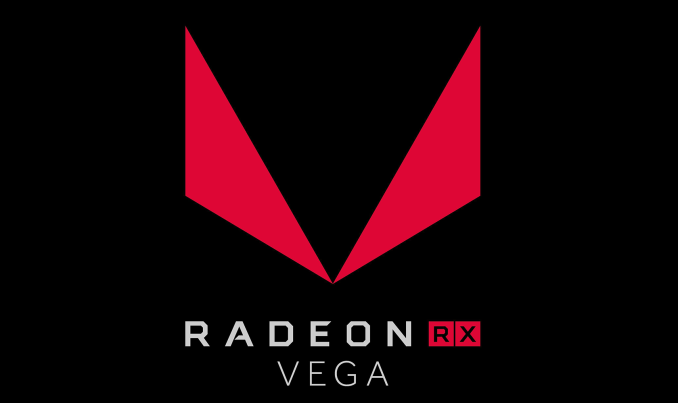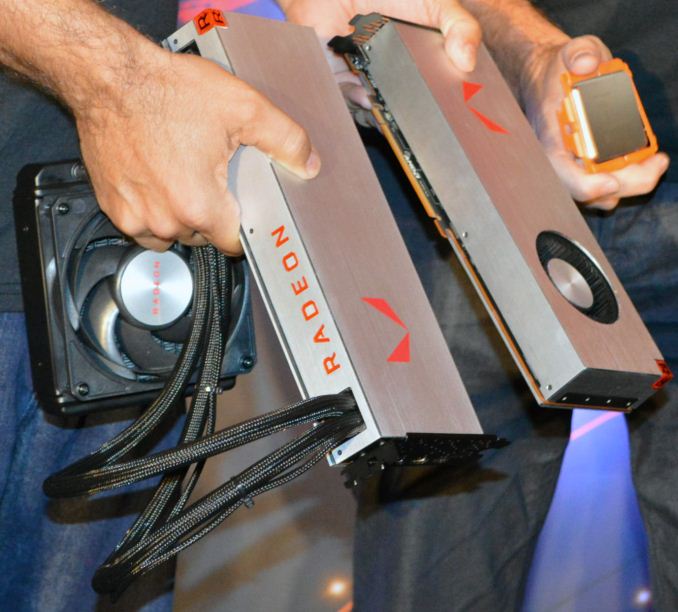Spotted: AMD's Radeon RX Vega, Air & Liquid Cooled
by Ryan Smith on July 29, 2017 9:20 PM EST
In a very brief update this evening, as part of their trickle marketing campaign, AMD has allowed us to release photos of two of their upcoming Radeon RX Vega cards. Cards as in plural, you say? Yes, just like the already-released Radeon Frontier Edition cards, RX Vega will come in air and liquid cooled variants.
To little surprise, both cards look like a palette swap of their Frontier Edition counterparts, with the same brushed metal finish, fan position, and Radeon "R" logo in the corner. However for any other information besides that, well, AMD is saving that for another time...











47 Comments
View All Comments
eva02langley - Sunday, July 30, 2017 - link
http://wccftech.com/amd-rx-vega-64-pricing-clocks-...Price leaked
AMD Radeon RX Vega 64 Air: $499
AMD Radeon RX Vega 64 Air Limited Edition: $549
AMD Radeon RX Vega 64 Liquid : $599
AMD Radeon RX Vega 64 Liquid Limited Edition : $649 [UPDATED $649/$699]
AMD Radeon RX Vega 56 : Pending [UPDATED $399]
All in all, I don't believe it will match a TI, however, pricing look better than expected.
Dragonstongue - Sunday, July 30, 2017 - link
LOLZ using them as a source of proof, they leak leaks from leaks.Bullwinkle J Moose - Sunday, July 30, 2017 - link
Not many people seemed to notice when SSD's hit $1 per GigabyteBut they started noticing bigtime when SSD's hit 50 cents/GB
Call me when I can get a graphics card for $1 per Watt
I'd buy a 1080Ti Kingpin for $250
But for AMD, I think I'll wait for 50 cents/Watt
It will be a long wait for sure
WatcherCK - Sunday, July 30, 2017 - link
I cant see what fittings are used or how the fan is connecting to the motherboard but im guessing they would not be easily modified? Im curious how if you could get the fan and rad off and attach it to an existing cooling loop...???JayzTwoCents did a clip recently where he expands a Fractal Design Celsius S36 AIO https://www.youtube.com/watch?v=fDeDnm3V3j4
It would look fairly dogsballsey and you are mixing who knows how many different types of loop components, you are definitely doing some unfriendly things to your warranty... you need to add a reservoir... on the plus side you are spending $250NZ (no idea what you would need in the final build) and getting a CPU+GPU loop at an intermediate difficulty build level...
And yes I guess you could just add am S36 and a watercooled Vega to a system and not combine the loops... the GPU loop is a single 140mm (w.a.g) radiator, the S36 with its 360mm radiator is going to give a better cooling area for the component that is producing more heat that the less than 95W produced by the CPU and for a less complicated build than a full custom loop...
And yes I have never done any kind of liquid cooling so my napkin math may be completely flawed, interesting idea though, feasible?
zangheiv - Sunday, July 30, 2017 - link
If you're a gamer and nothing else, then perhaps Nvidia is a better choice for you...that's great. But if you want to save a few hundred dollars and don't mind a bit less gaming performance but prefer a higher overall compute performance then Vega is for you. If you're a Data Center, then Vega is a great choice/alternative for you. If provide a cloud-based virtualized GPU service (VDI or virtual gaming consoles etc) then Vega is for you. If you're a developer rendering large workloads Vega is better choice. If you're developing an APU or SoC (Raven Ridge) that needs a GPU with infinity-fabric and HSA to capture market-share and make mobile devices higher-performance and lower cost then Vega is a darn perfect architecture. If you're a Miner, then unfortunate for the rest of us, Vega will stocks will probably be swept up by the miners if it were priced like a GTX1080There were a few sacrifices Vega had to make in order to solve a much bigger problem. I believe the TSMC 16nm node is also more efficient than the Samsung 14nm node so it can be clocked higher and consume less power, but samsung has much better yield which in turn affects price. I see this as a fair trade-off.
Vega brings a lot of architectural changes most that will compete against Volta. Some folks think Vega is just catching up to Maxwell, that's plain wrong. Driver-wise Vega has a bunch of features that are not even enabled yet which is why it's just performing like it was a 14nm Fiji. Give it some time and then this beast will start to open up. And once that's done, we'll be ready for 7nm Navi.
I think AMD is actually ahead of Nvidia in the Exascale race, put 40,000 o Vegas into 10,000 EPYC servers interconnected infinity fabric with HSA APIs and we have 1+ ExaFLOP environment that lower cost and higher efficiency than an intel/nvidia solution.
ILostIT - Sunday, July 30, 2017 - link
Amd pushed GlobalFoundries14nmLP to the clock and voltage wall so it appears to be less efficient than TSMC 16nmFF(Because LP processes shine at low voltage and low clocks i.e. smartphone SoCs)Bullwinkle J Moose - Sunday, July 30, 2017 - link
Zangheiv says...."Some folks think Vega is just catching up to Maxwell, that's plain wrong. Driver-wise Vega has a bunch of features that are not even enabled yet which is why it's just performing like it was a 14nm Fiji."
-------------------------------------------------------------------------------------------------------
Sorry Zangheiv, but Vega will never catch up to Maxwell (Driver-wise)
Windows XP is not supported by Vega Drivers!